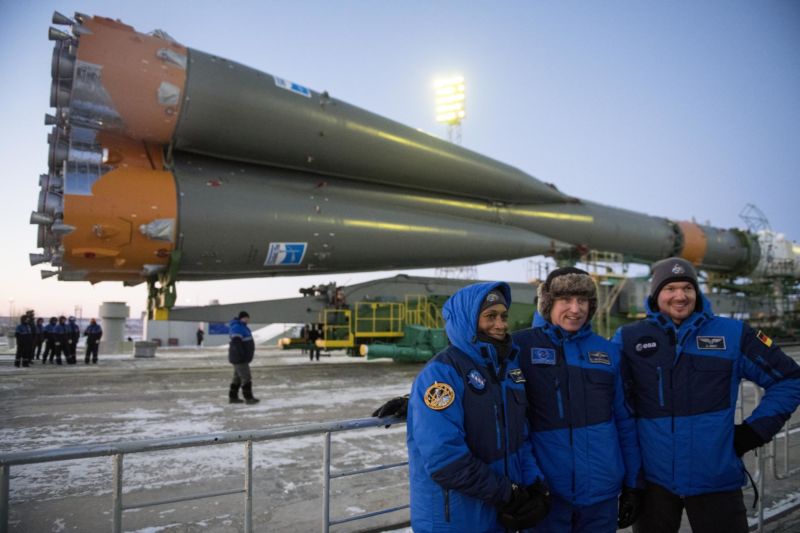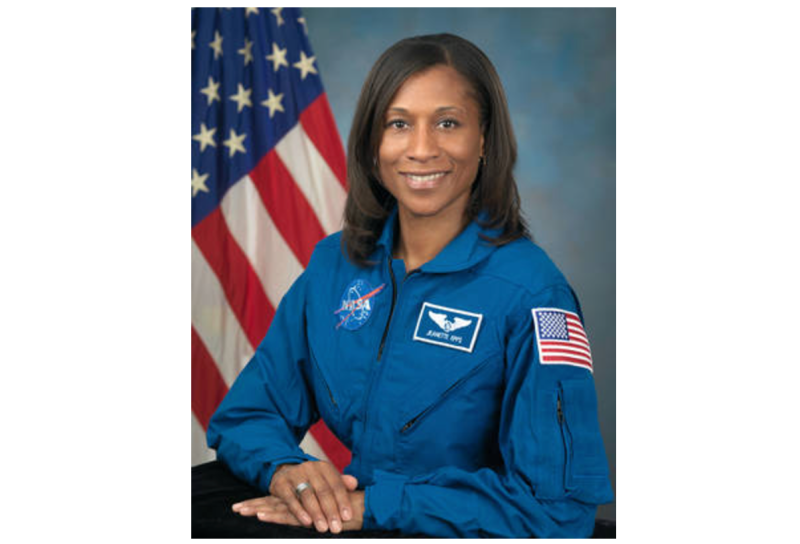- Joined
- Aug 28, 2011
- Messages
- 3,990
- Points
- 63
https://arstechnica.com/science/201...tte-epps-just-months-before-her-first-flight/
NASA has pulled Jeanette Epps just months before her first flight
Epps would have been the first African-American crew member on board the ISS.
Eric Berger - 1/19/2018, 8:00 AM

Enlarge / Jeanette Epps, left, served as a back-up crew member to Expedition 54 to the space station.
NASA
457
NASA issued a short news release on Thursday evening stating that Jeanette Epps will not be a part of the International Space Station crew set to launch in June. (That flight would launch from Kazakhstan aboard a Soyuz rocket.) The release gave no reason why Epps was pulled from the flight.
In a response to a request for more information, Johnson Space Center spokeswoman Brandi Dean told Ars, "A number of factors are considered when making flight assignments. However, these decisions are personnel matters for which NASA doesn’t provide information."
According to NASA, Epps had returned to the active Astronaut Corps at the space center to assume duties in the astronaut office. She will be considered for assignment to future missions. Had she flown this year, Epps would have become the first African-American astronaut to live as a crew member aboard the International Space Station. Only three other African American women have flown into space. Epps' assignment in January 2017 garnered a fair amount of favorable publicity for the space agency.
NASA’s internal schedule for the commercial crew program is pretty grim
Epps was a member of NASA's 20th class of astronauts, a group of nine known as the "Chumps" who were selected in June 2009. Seven of the nine astronauts from that class have already flown into space. Epps will be replaced by the other rookie from the 2009 class, Serena Auñón-Chancellor, who was serving as Epps' backup for this mission.
Crew members have been pulled from their flights much later than this. In 1970, Ken Mattingly was pulled from his assignment as command module pilot of the Apollo 13 just a week before launch. (Gary Sinise played him in the 1995 film.) That was because the primary crew was exposed to rubella, and Mattingly was not immune from the disease. NASA does not usually say why crews are reassigned unless there is a medical reason. In that case, NASA will sometimes provide limited information.
Latest Ars Video >
The Greatest Leap, Episode 3: Triumph
In honor of the 50th anniversary of the beginning of the Apollo Program, Ars Technica brings you an in depth look at the Apollo missions through the eyes of the participants.
Eric Berger Eric Berger is the senior space editor at Ars Technica, covering everything from astronomy to private space to wonky NASA policy. A certified meteorologist, Eric lives in Houston.
Email [email protected] // Twitter @SciGuySpace
reader comments 457
Share this story
https://spaceflightnow.com/2018/01/19/astronaut-jeanette-epps-bumped-from-space-station-flight/
Astronaut Jeanette Epps bumped from space station flight
January 19, 2018 Stephen Clark

NASA astronaut Jeanette Epps participates in a news conference Nov. 30 in Star City, Russia. Credit: Andrey Shelepin/Gagarin Cosmonaut Training Center
NASA said Thursday that rookie astronaut Serena Auñón-Chancellor will replace Jeanette Epps on an expedition set for launch to the International Space Station in June.
The space agency did not disclose a reason for the crew change, and a NASA spokesperson offered no details on the decision.
“A number of factors are considered when making flight assignments,” the spokesperson said. “These decisions are personnel matters for which NASA doesn’t provide information.”
The space agency announced Epps’ assignment to the Expedition 56 and 57 crews in January 2017. The Syracuse, New York, native would have become the first African American astronaut to live and work aboard the station on a long-duration mission, and the fourth African American woman to fly in space.
Epps was training for her first space mission after her selection as an astronaut in 2009, and she was featured in Woman’s Day magazine last year in the run-up to her space station expedition. Epps was scheduled for launch June 6 aboard the Russian Soyuz MS-09 spacecraft with veteran European Space Agency astronaut Alexander Gerst and rookie Russian cosmonaut Sergey Prokopyev.
NASA has previously removed astronauts from flights due to medical issues. Apollo 13 astronaut Ken Mattingly was replaced by Jack Swigert three days before launch in 1970, and shuttle astronaut Tim Kopra was replaced by Steve Bowen around a month before a launch in early 2011.
But space station crews, which spend more time in training for a mission than shuttle astronauts, have been largely immune to late changes.
Epps was a member of the backup crew for the most recent launch of residents to the space station in December. She traveled to the Baikonur Cosmodrome in Kazakhstan in case a last-minute replacement was needed.
She will return to NASA’s Johnson Space Center in Houston, the home base for the agency’s astronaut corps, to be considered for an assignment to a future mission, officials said in a statement.
Epps earned a Ph.D. in aerospace engineering from the University of Maryland in 2000, and worked as a research engineer at Ford and as a CIA technical intelligence officer before joining NASA.
Auñón-Chancellor, Epps’ classmate in the 2009 astronaut group, was assigned to the station’s Expedition 58 and 59 crews and preparing for a launch on the Soyuz MS-11 spaceship in November. She will move up in the queue to take Epps’ seat for the June launch with Gerst and Prokopyev, and Anne McClain, another first-time flier from 2013 astronaut class, will train for the November mission.

Astronaut Serena Auñón-Chancellor pictured during spacewalk training in 2012. Credit: NASA/Robert Markowitz
Hailing from Fort Collins, Colorado, Auñón-Chancellor holds a medical degree from the University of Texas Health Science Center at Houston and a master’s degree in public health from the University of Texas Medical Branch.
She became a NASA flight surgeon 2006 and spent more than nine months in Russia supporting medical operations for space station crew members, then served as deputy medical lead for NASA’s Orion spacecraft prior to her selection as an astronaut.
Gerst, Prokopyev and Auñón-Chancellor will spend 143 days in space before their scheduled return to Earth in late October.
McClain, a graduate of the U.S. Military Academy at West Point and a U.S Army major, will join Russian cosmonaut Oleg Kononenko and Canadian flight engineer David Saint-Jacques on the Soyuz MS-11 crew capsule set for liftoff from Kazakhstan in November.
The trio will live on the station nearly six months before landing in May 2019.
McClain was an Army Kiowa Warrior attack helicopter pilot and flew combat missions in Iraq before becoming an astronaut. A native of Spokane, Washington, she graduated from the U.S. Naval Test Pilot School and earned master’s degrees in aerospace engineering and international relations from the University of Bath and the University of Bristol in England.
Email the author.
Follow Stephen Clark on Twitter: @StephenClark1.
NASA has pulled Jeanette Epps just months before her first flight
Epps would have been the first African-American crew member on board the ISS.
Eric Berger - 1/19/2018, 8:00 AM

Enlarge / Jeanette Epps, left, served as a back-up crew member to Expedition 54 to the space station.
NASA
457
NASA issued a short news release on Thursday evening stating that Jeanette Epps will not be a part of the International Space Station crew set to launch in June. (That flight would launch from Kazakhstan aboard a Soyuz rocket.) The release gave no reason why Epps was pulled from the flight.
In a response to a request for more information, Johnson Space Center spokeswoman Brandi Dean told Ars, "A number of factors are considered when making flight assignments. However, these decisions are personnel matters for which NASA doesn’t provide information."
According to NASA, Epps had returned to the active Astronaut Corps at the space center to assume duties in the astronaut office. She will be considered for assignment to future missions. Had she flown this year, Epps would have become the first African-American astronaut to live as a crew member aboard the International Space Station. Only three other African American women have flown into space. Epps' assignment in January 2017 garnered a fair amount of favorable publicity for the space agency.
NASA’s internal schedule for the commercial crew program is pretty grim
Epps was a member of NASA's 20th class of astronauts, a group of nine known as the "Chumps" who were selected in June 2009. Seven of the nine astronauts from that class have already flown into space. Epps will be replaced by the other rookie from the 2009 class, Serena Auñón-Chancellor, who was serving as Epps' backup for this mission.
Crew members have been pulled from their flights much later than this. In 1970, Ken Mattingly was pulled from his assignment as command module pilot of the Apollo 13 just a week before launch. (Gary Sinise played him in the 1995 film.) That was because the primary crew was exposed to rubella, and Mattingly was not immune from the disease. NASA does not usually say why crews are reassigned unless there is a medical reason. In that case, NASA will sometimes provide limited information.
Latest Ars Video >
The Greatest Leap, Episode 3: Triumph
In honor of the 50th anniversary of the beginning of the Apollo Program, Ars Technica brings you an in depth look at the Apollo missions through the eyes of the participants.
Eric Berger Eric Berger is the senior space editor at Ars Technica, covering everything from astronomy to private space to wonky NASA policy. A certified meteorologist, Eric lives in Houston.
Email [email protected] // Twitter @SciGuySpace
reader comments 457
Share this story
https://spaceflightnow.com/2018/01/19/astronaut-jeanette-epps-bumped-from-space-station-flight/
Astronaut Jeanette Epps bumped from space station flight
January 19, 2018 Stephen Clark

NASA astronaut Jeanette Epps participates in a news conference Nov. 30 in Star City, Russia. Credit: Andrey Shelepin/Gagarin Cosmonaut Training Center
NASA said Thursday that rookie astronaut Serena Auñón-Chancellor will replace Jeanette Epps on an expedition set for launch to the International Space Station in June.
The space agency did not disclose a reason for the crew change, and a NASA spokesperson offered no details on the decision.
“A number of factors are considered when making flight assignments,” the spokesperson said. “These decisions are personnel matters for which NASA doesn’t provide information.”
The space agency announced Epps’ assignment to the Expedition 56 and 57 crews in January 2017. The Syracuse, New York, native would have become the first African American astronaut to live and work aboard the station on a long-duration mission, and the fourth African American woman to fly in space.
Epps was training for her first space mission after her selection as an astronaut in 2009, and she was featured in Woman’s Day magazine last year in the run-up to her space station expedition. Epps was scheduled for launch June 6 aboard the Russian Soyuz MS-09 spacecraft with veteran European Space Agency astronaut Alexander Gerst and rookie Russian cosmonaut Sergey Prokopyev.
NASA has previously removed astronauts from flights due to medical issues. Apollo 13 astronaut Ken Mattingly was replaced by Jack Swigert three days before launch in 1970, and shuttle astronaut Tim Kopra was replaced by Steve Bowen around a month before a launch in early 2011.
But space station crews, which spend more time in training for a mission than shuttle astronauts, have been largely immune to late changes.
Epps was a member of the backup crew for the most recent launch of residents to the space station in December. She traveled to the Baikonur Cosmodrome in Kazakhstan in case a last-minute replacement was needed.
She will return to NASA’s Johnson Space Center in Houston, the home base for the agency’s astronaut corps, to be considered for an assignment to a future mission, officials said in a statement.
Epps earned a Ph.D. in aerospace engineering from the University of Maryland in 2000, and worked as a research engineer at Ford and as a CIA technical intelligence officer before joining NASA.
Auñón-Chancellor, Epps’ classmate in the 2009 astronaut group, was assigned to the station’s Expedition 58 and 59 crews and preparing for a launch on the Soyuz MS-11 spaceship in November. She will move up in the queue to take Epps’ seat for the June launch with Gerst and Prokopyev, and Anne McClain, another first-time flier from 2013 astronaut class, will train for the November mission.

Astronaut Serena Auñón-Chancellor pictured during spacewalk training in 2012. Credit: NASA/Robert Markowitz
Hailing from Fort Collins, Colorado, Auñón-Chancellor holds a medical degree from the University of Texas Health Science Center at Houston and a master’s degree in public health from the University of Texas Medical Branch.
She became a NASA flight surgeon 2006 and spent more than nine months in Russia supporting medical operations for space station crew members, then served as deputy medical lead for NASA’s Orion spacecraft prior to her selection as an astronaut.
Gerst, Prokopyev and Auñón-Chancellor will spend 143 days in space before their scheduled return to Earth in late October.
McClain, a graduate of the U.S. Military Academy at West Point and a U.S Army major, will join Russian cosmonaut Oleg Kononenko and Canadian flight engineer David Saint-Jacques on the Soyuz MS-11 crew capsule set for liftoff from Kazakhstan in November.
The trio will live on the station nearly six months before landing in May 2019.
McClain was an Army Kiowa Warrior attack helicopter pilot and flew combat missions in Iraq before becoming an astronaut. A native of Spokane, Washington, she graduated from the U.S. Naval Test Pilot School and earned master’s degrees in aerospace engineering and international relations from the University of Bath and the University of Bristol in England.
Email the author.
Follow Stephen Clark on Twitter: @StephenClark1.






